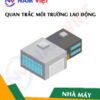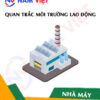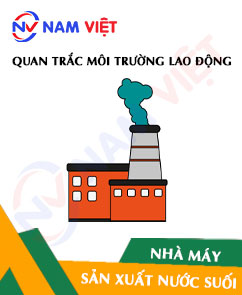Occupational environment monitoring at the factory producing musical instruments
99,000 ₫
Note: The above price is calculated for one sample. Prices may fluctuate depending on the area of the environment to be monitored and market conditions. For more accurate pricing support, please refer to the price list or contact our consulting staff directly.
Workplace environment monitoring for a musical instrument manufacturing factory is a session of collecting, analyzing, and evaluating factors at the workplace that may be harmful to workers health.
Table of Contents
Toggle1. Overview of Musical Instrument Manufacturing Factories
a. What is a musical instrument manufacturing factory?
A manufacturing factory for musical instruments is a production facility that designs and manufactures various musical instruments such as pianos, guitars, drums, saxophones, violins, and many other instruments. This factory has production processes and stages designed to create high-quality musical instruments that meet the needs of musicians and the market.
Musical instrument manufacturing factories often use a variety of specialized machinery and equipment such as wood processing machines, metal cutting machines, sound tuning machines, coating machines, and other specialized tools to carry out production stages accurately and efficiently.

b. Production stages in a musical instrument manufacturing factory
The production stages in a musical instrument factory may include the following:
- Material preparation: Depending on the type of instrument, materials such as wood, metal, plastic, strings, and other components are prepared and cut to the appropriate sizes for each part of the instrument.
- Component manufacturing: Instrument components are produced, including necks, bodies, soundboards, keys, pads, screws, tuning pegs, and other parts. This process may involve wood processing, wood pressing, metal cutting, casting, or plastic fabrication.
- Assembly: Components are assembled to create a complete instrument. The neck and body are joined, the soundboard is attached, and keys and pads are installed. Parts such as strings, tuning pegs, and adjustment knobs are also installed.
- Sound tuning: After assembly, the instrument is tuned to ensure proper sound quality. Tuning involves adjusting string tension, soundboard thickness, or modifying components like knobs to achieve the desired sound.
- Finishing and coating: Instruments are finished by sanding, coating, and refining surfaces. This may include smoothing the wood surface, applying paint or natural wood finish, and adding protective layers such as wax or oil.
- Inspection and quality control: Instruments are checked to ensure they meet technical standards and requirements. Inspection may include sound testing, mechanical testing, adjustment checks, and other evaluations to ensure high-quality performance.
- Packing and transportation: Finally, instruments are carefully packed to ensure safety during shipping and delivery to customers. Packaging usually includes sturdy cases, protective materials such as foam or paper, and accompanying accessories like user manuals.

c. Machinery used in musical instrument manufacturing factories
In musical instrument manufacturing factories, various machinery and equipment are used for production and processing. Some commonly used machines include:
- Wood cutting machines: Used to cut and shape wooden parts of instruments such as bodies, necks, soundboards, and other components.
- Metal lathes: Used to process metal components such as necks, keys, and other parts.
- Wood pressing machines: Used to press wood into sheets required for instrument parts.
- String manufacturing machines: Used to produce strings for instruments such as guitars, pianos, violins, and others.
- Surface finishing machines: Used to sand, polish, and finish wooden or metal surfaces of instruments.
- Sound testing machines: Used to check the sound quality and performance of instruments.
- Grinding, cutting, and laser engraving machines: Used for precision operations such as sanding soundboards, cutting small parts, and engraving text or patterns on instrument surfaces.
- Compression and assembly machines: Used to assemble instrument components, such as attaching necks to bodies, installing keys, and other components.
- Coating machines: Used to apply finishes to instrument parts, including paint or natural wood finishes.
- Packing machines: Used to pack the final products, including cases and protective materials.

d. Occupational diseases in musical instrument factories
Workers in musical instrument factories may be exposed to the following occupational diseases:
- Respiratory diseases: Exposure to dust, strong fumes, chemical vapors, or coating substances may lead to respiratory problems, including rhinitis, bronchitis, pneumonia, and other respiratory issues.
- Skin diseases: Contact with chemicals during production can cause skin irritation, dermatitis, eczema, and cracking of hand skin.
- Hearing problems: Working in loud environments may damage hearing and cause auditory issues, including hearing loss and tinnitus.
- Musculoskeletal disorders: Production stages may require repetitive force or awkward postures, leading to back, shoulder, neck, and other musculoskeletal problems.
- Heat-related illnesses: In hot, hazardous, or poorly ventilated workplaces, risks of heat exhaustion, heat stroke, and malnutrition increase.
To ensure safety and protect workers’ health, personal protective measures such as masks, ear protection, gloves, protective clothing, and safety glasses should be applied. Additionally, providing occupational safety training, maintaining a clean and ventilated workplace, and supplying safety equipment and chemical control are crucial measures to reduce the risk of occupational diseases.

e. Popular musical instruments on the market
Some popular musical instruments on the market include:
- Piano: One of the most common and versatile instruments, including grand piano, upright piano, and digital piano.
- Guitar: A widely used string instrument, including acoustic guitar, electric guitar, and bass guitar.
- Drums: Includes drum sets, bongos, congas, cajons, and various percussion instruments important for rhythm sections and bands.
- Saxophone: A woodwind instrument widely used in jazz and orchestral music.
- Violin: A classical string instrument used in classical music and other genres.
- Trombone: A brass wind instrument used in bands and orchestras.
- Keyboard: A versatile instrument capable of producing the sounds of many instruments, widely used across music genres.
- Harmonica: A small wind instrument used in various music genres, especially blues and folk.
- Cajon: A wooden percussion instrument played by hand or stick, commonly used in folk and Flamenco music.
- Moon lute: A string instrument shaped like a crescent moon, commonly used in traditional Chinese music.
2. Overview of occupational environment monitoring services
a. What is occupational environment monitoring in musical instrument factories?
Occupational environment monitoring (or workplace environment assessment) in musical instrument factories involves collecting, evaluating, and analyzing measured indicators of workplace environmental factors in order to take timely actions, minimize environmental impacts on worker health, and prevent occupational diseases. This monitoring is mandatory for musical instrument factories.
Occupational environment monitoring is crucial for maintaining, protecting, and enhancing worker health, as workers are the primary resource of the company and directly generate profit. Workers frequently exposed to risk factors beyond allowed standards are at risk of health problems and occupational diseases.
REGISTER FOR OCCUPATIONAL ENVIRONMENT MONITORING SERVICE
b. Nam Viet’s occupational environment monitoring program
Nam Viet’s occupational environment monitoring program is designed by monitoring engineers specializing in occupational safety and environmental protection. To ensure worker health and safety, the program uses modern measurement methods to monitor air quality, water, microclimate, physical factors, dust, and other workplace conditions. This program is vital for ensuring a safe working environment and protecting workers’ health.
Additionally, Nam Viet’s monitoring program plays a key role in researching and developing solutions to improve workplace environmental quality. With a dedicated and professional monitoring team, Nam Viet’s exclusive monitoring program is a breakthrough in occupational safety and environmental management in Vietnam.

c. Standardization in occupational environment measurement procedures
Standardization in Nam Viet’s occupational environment measurement procedures is critical for ensuring the accuracy and reliability of results. The program applies recognized standards and procedures from the Ho Chi Minh City Department of Health. This ensures that collected data is reliable for evaluating workplace conditions and making decisions to improve the environment and protect worker health.
Standard procedures also ensure that measurements are performed by highly qualified monitoring specialists with years of experience, enabling managers and experts to trust the results from An Toàn Nam Việt and make accurate decisions valuable for worker health and environmental protection.
By applying standardization in measurement procedures, Nam Viet demonstrates its commitment to ensuring a safe workplace and protecting workers’ health, while actively contributing to improving occupational safety management and environmental protection quality in Vietnam.
d. Monitoring report for musical instrument factories
Workplace monitoring results are prepared according to Form 04, Appendix III, issued with Decree 44/2016/ND-CP and prepared in two copies: one copy sent to the enterprise that contracted the monitoring service and one retained by the monitoring organization.
The retention period for monitoring results follows legal regulations and is indefinite.

e. Frequency of occupational environment monitoring according to law
According to Clause 2, Article 18 of the Law on Occupational Safety and Hygiene 84/2015/QH13, employers must conduct workplace environment monitoring to assess harmful factors at least once a year.
f. Deadline for submitting occupational environment monitoring reports
The deadline for submission is before December 31 each year. Enterprises operating manufacturing facilities are required to submit monitoring reports to the Department of Health at the localities where the enterprise is headquartered and where workers are employed.
If there are changes in technology, production processes, or upgrades that may introduce new hazards to worker health, enterprises must update their occupational hygiene records regarding harmful factors requiring environmental monitoring.
g. Penalties for violations of occupational environment monitoring regulations for employers
According to Article 27 of Decree No. 12/2022/ND-CP dated January 17, 2022, on administrative penalties in labor, social insurance, and overseas employment for Vietnamese workers:
- Clause 2: Fines from 2,000,000 – 5,000,000 VND for employers who fail to publicly disclose monitoring results to workers at the workplace and where hazard management is conducted immediately after receiving the results.
- Clause 3: Fines from 20,000,000 – 40,000,000 VND for employers who do not conduct occupational environment monitoring to control health hazards as required by law.
- Clause 4: Fines from 40,000,000 – 60,000,000 VND for employers who collaborate with monitoring organizations to commit fraud in environmental monitoring activities but not to the extent of criminal liability.
3. Harmful environmental factors for workers in musical instrument manufacturing factories
In musical instrument manufacturing factories, there are several environmental factors that can be harmful to workers. The following are some examples:
- Noise: Excessive noise from production processes and machinery operations in the factory can seriously affect workers’ hearing. Prolonged exposure to high noise levels can lead to auditory issues such as hearing loss and tinnitus.
- Dust and fine particles: Machining and machinery operations can generate dust and fine particles in the air. These small particles can be inhaled into the lungs, causing respiratory problems and difficulty breathing. Additionally, exposure to chemical compounds in some raw materials and cleaning agents can also harm the respiratory system.
- Chemicals: Musical instrument production may involve the use of chemical compounds such as solvents, adhesives, paints, and coatings. Prolonged exposure to these substances can cause skin, eye, and respiratory irritation, as well as other serious health issues.
- Temperature and humidity: Some production processes may create a working environment with high temperature and humidity, especially during drying and finishing stages. These conditions can make body temperature regulation difficult, causing fatigue, dehydration, and discomfort for workers.
- Ergonomic impact: Certain production stages may require workers to maintain uncomfortable or specific postures. This can lead to muscle strain, discomfort, back and neck pain, and musculoskeletal problems.
REGISTER FOR OCCUPATIONAL ENVIRONMENT MONITORING SERVICE
4. Measures to improve working conditions in musical instrument manufacturing factories
To improve working conditions in musical instrument manufacturing factories and protect worker health, the following measures can be implemented:
- Noise control: Use technical measures such as soundproofing, installing noise barriers, and providing personal hearing protection to reduce factory noise.
- Dust and fine particle management: Ensure effective ventilation and dust extraction systems to remove dust and fine particles from the air. Provide personal protective equipment such as masks to prevent inhalation.
- Chemical management: Use safe and non-toxic alternatives, ensure proper storage, use, and handling of chemicals. Provide sufficient safety information and usage instructions to workers.
- Temperature and humidity control: Maintain a stable and comfortable working environment through air conditioning systems and humidity control.
- Training and education: Provide comprehensive training and education on occupational safety, PPE usage, chemical management, and preventive measures for occupational diseases. Enhance awareness of health and safety practices and ensure compliance with labor safety regulations.
- Design and technological improvements: Apply advanced designs and technologies to reduce noise, dust, and other harmful factors. Explore and adopt clean production methods to minimize waste and pollution during production.
- Assessment and monitoring: Conduct regular assessments of the working environment and monitor workers’ health to detect issues early and implement corrective measures.
- Periodically conduct occupational environment monitoring in factories, collect and analyze harmful factors affecting workers, and adjust to reduce hazards to prevent occupational diseases.
5. Benefits of periodic monitoring in musical instrument manufacturing factories
An Toan Nam Viet provides businesses with significant benefits when using occupational environment monitoring services in accordance with Decree 44/2016/ND-CP on managing and controlling harmful workplace factors affecting employees.
- Businesses can proactively control harmful factors in workshops or factories.
- Receive consultation and recommendations on measures to reduce harmful factors and improve workplace environment quality.
- Indirectly protect human resources, a key factor in business development.
- Reduce the harmful effects of occupational diseases on health, thereby minimizing future treatment costs.
- Enhance worker health, ensuring product quality and maintaining production output.
- Ensure compliance with labor safety laws, avoiding legal risks.
- Enhance credibility and professionalism in all aspects, thereby elevating the company’s brand.
Nam Viet’s environmental monitoring service is a solution to reduce occupational disease risks, contributing to a clean and high-quality working environment.

6. National occupational environment monitoring center
Occupational environment monitoring center of Nam Viet is a professional unit specializing in monitoring and measuring workplace environmental quality across all provinces in Vietnam. With a team of experienced monitoring specialists, the center uses modern measurement equipment to ensure accuracy and reliability.
Besides monitoring services, the center assists clients in planning, managing, and tracking occupational environmental issues. With the motto “customer-centered,” the center prioritizes client satisfaction, meets all client needs, and commits to providing the best solutions for businesses.
REGISTER FOR OCCUPATIONAL ENVIRONMENT MONITORING SERVICE
With investments in technology, equipment, and human resources, Nam Viet’s monitoring center has become one of the most reputable units in occupational environment monitoring in Ho Chi Minh City, with the following objectives:
- We always value our brand reputation and the quality of our service products.
- We provide clients with the best and most suitable solutions possible.
- With a team of experienced Masters and Engineers, committed to environmental protection and benefiting businesses.
- By choosing Nam Viet Environmental Monitoring, companies receive professional service from experts and the best cost advantages.
The occupational environment monitoring process at Nam Viet includes the following basic steps:
- Before monitoring, we ensure all equipment is calibrated according to legal regulations.
- Follow occupational environment monitoring procedures committed to the Department of Health accurately and fully.
- Report monitoring results honestly to employers.
- If monitoring results indicate unsafe conditions, Nam Viet provides corrective solutions, and the workplace implements the following:
- Implement measures to improve working conditions, minimize harmful factor impacts, and prevent occupational diseases.
- Conduct health examinations to detect occupational and related diseases early for workers in unsafe environments.
- Provide in-kind compensation to workers according to labor law.

7. Occupational environment monitoring quotation
To help businesses conduct professional and effective occupational environment monitoring, Nam Viet provides clients with a quotation for occupational environment monitoring services that is high-quality and reasonably priced.
- Our quotation provides detailed pricing information for the monitoring services we offer, including costs related to travel, measurement, analysis, and reporting. Clients can trust the accuracy and reliability of the monitoring reports we provide.
- We commit to offering competitive and reasonable prices in the market and are always ready to provide quick and professional advice for any inquiries regarding monitoring services.
- With Nam Viet’s monitoring quotation, clients can easily select service packages suitable to their needs. We are committed to delivering the highest satisfaction with professional service quality.
No comments yet












Review Occupational environment monitoring at the factory producing musical instruments
There are no reviews yet.